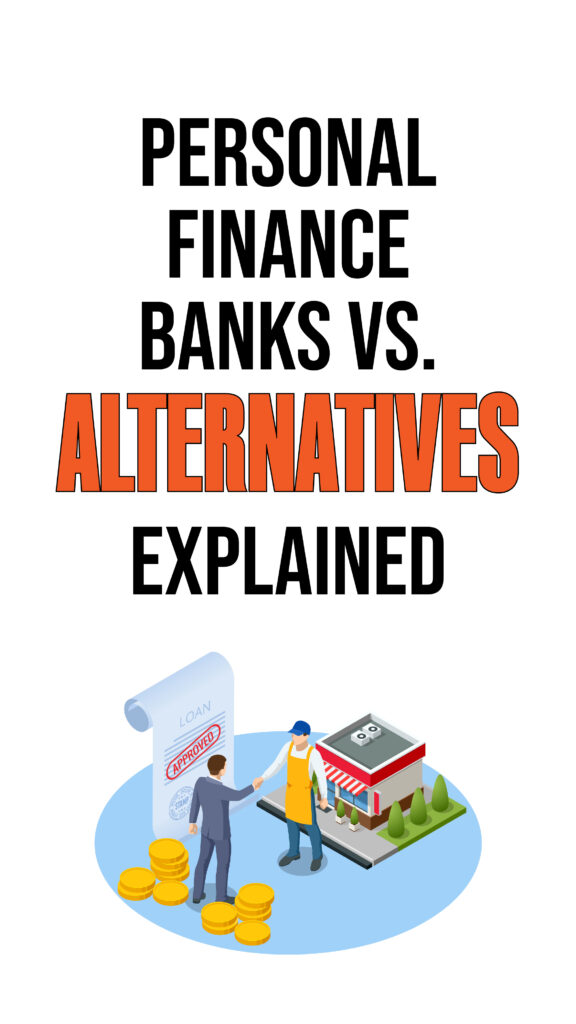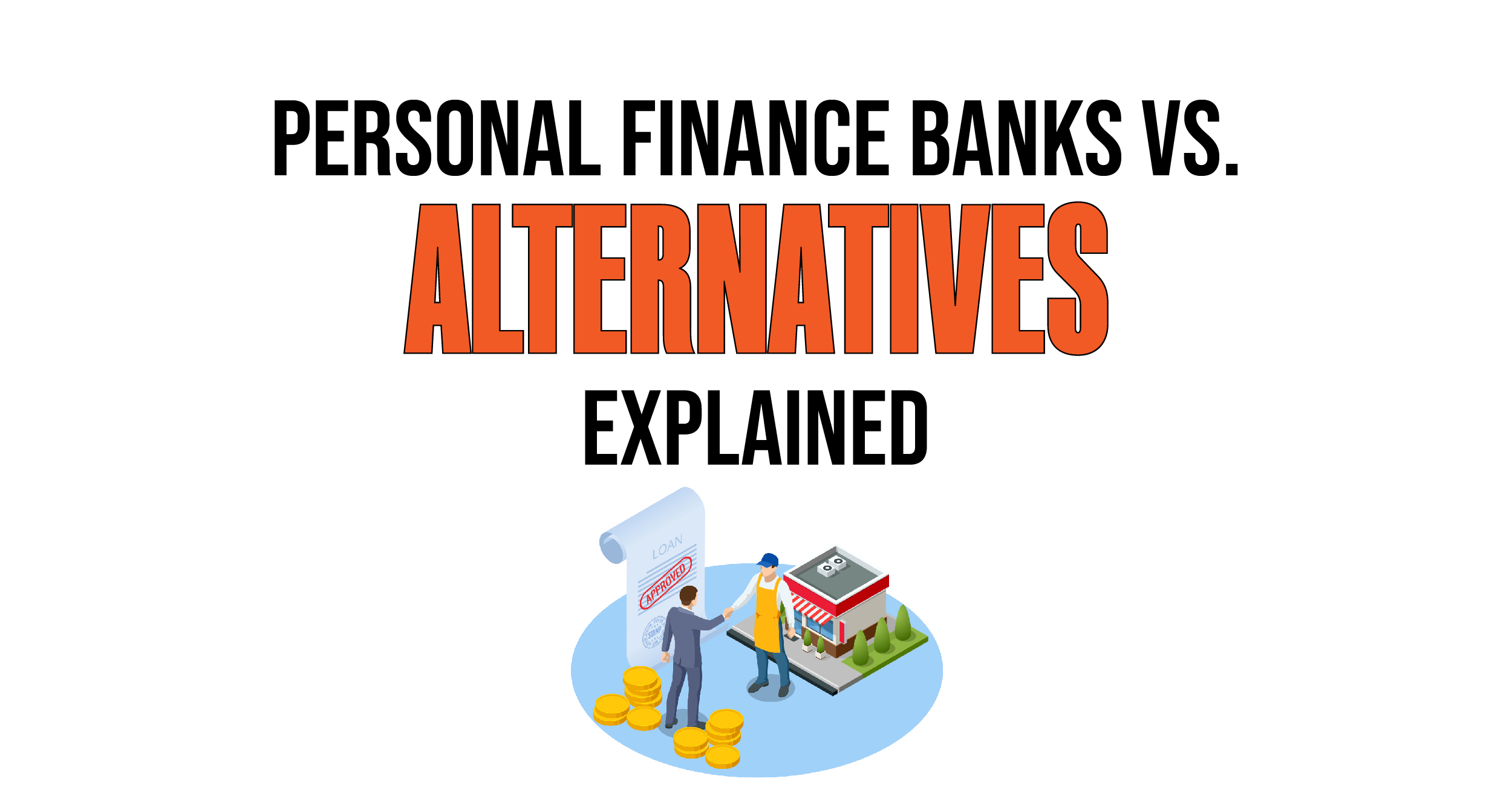Banks and alternatives offer various financial services. Understanding their differences can help you make informed personal finance decisions.
Banks are traditional financial institutions providing savings, loans, and checking accounts. They offer security and convenience but may have higher fees and lower interest rates. Credit unions are member-owned alternatives with lower fees and better rates but limited accessibility. Online banks and fintech companies provide innovative services like higher interest rates and low fees, but they lack physical branches.
Peer-to-peer lending platforms offer direct loans between individuals, often with better terms. Considering these options helps you optimize your personal finance strategy by balancing convenience, cost, and accessibility. Choose the option that aligns with your financial goals and lifestyle.
Introduction To Personal Finance
Personal finance is the art of managing your money. This includes budgeting, saving, investing, and planning for the future. Good personal finance skills can lead to a secure financial future.
Understanding personal finance helps you make better financial decisions. It helps you avoid debt and build wealth over time.
Importance Of Financial Literacy
Financial literacy means knowing how to manage your money. It helps you make smart choices about spending and saving. People with good financial literacy are less likely to get into debt.
Financial literacy also helps you plan for big life events. This includes buying a house, sending kids to college, and retiring comfortably.
Goals Of Personal Finance
Personal finance goals help you plan your financial future. Here are some common goals:
- Saving Money: Putting aside money for emergencies and future needs.
- Investing: Growing your money through stocks, bonds, or real estate.
- Budgeting: Planning your expenses to live within your means.
- Debt Management: Paying off loans and credit card debt.
- Retirement Planning: Ensuring you have enough money for your later years.

Credit: www.ft.com
Traditional Banking

Traditional banking has been the cornerstone of personal finance for decades. These institutions provide a range of services to help manage and grow your money. From savings accounts to loans, traditional banks offer a variety of solutions.
Types Of Banks
There are several types of banks, each serving different needs:
- Retail Banks: These banks serve individual customers. They offer personal banking services.
- Commercial Banks: These banks focus on businesses. They provide loans and other financial services to companies.
- Credit Unions: Member-owned institutions. They often offer better rates on loans and savings.
- Online Banks: These operate without physical branches. They often have lower fees and higher interest rates.
Services Offered
Traditional banks offer a variety of services:
| Service | Description |
|---|---|
| Savings Accounts | Store money and earn interest over time. |
| Checking Accounts | Manage daily expenses with ease. |
| Loans | Borrow money for various needs like buying a house or car. |
| Credit Cards | Use borrowed money with a promise to repay later. |
| Investment Services | Grow your money through stocks, bonds, and other investments. |
Traditional banks are regulated and insured. This means your money is safe. They also offer personalized services and in-person support.
Bank Accounts
Understanding bank accounts is key for managing money. Banks offer different accounts with unique features. Let’s explore the two most common types: checking and savings accounts.
Checking Accounts
Checking accounts are for daily transactions. You can deposit and withdraw money easily. These accounts often come with debit cards and checks.
Features of Checking Accounts:
- Easy access to funds
- Online banking
- Direct deposit options
- No or low interest
Savings Accounts
Savings accounts help you save money. They usually offer interest on your deposits. The interest rate can vary.
Benefits of Savings Accounts:
- Earn interest on savings
- Secure place for money
- Limited access to funds
Here’s a comparison table for quick reference:
| Feature | Checking Accounts | Savings Accounts |
|---|---|---|
| Purpose | Daily transactions | Savings |
| Interest | Low or none | Yes |
| Access | Unlimited | Limited |
| Tools | Debit card, checks | Passbook, online |
Credit Unions
Credit unions are unique financial institutions. They offer many of the same services as banks. But they operate differently. Members own and control them. This section explores how credit unions work and their benefits.
How Credit Unions Work
Credit unions are not-for-profit organizations. They focus on serving their members. Members pool their money to provide loans and other financial services. Each member has a say in how the credit union is run.
Here is a simple table explaining the differences between banks and credit unions:
| Feature | Credit Unions | Banks |
|---|---|---|
| Ownership | Members | Shareholders |
| Profit Model | Not-for-Profit | For-Profit |
| Decision Making | Member Votes | Board of Directors |
Benefits Of Credit Unions
Credit unions offer many benefits. Here are some key advantages:
- Lower Fees: Credit unions often have fewer and lower fees.
- Better Rates: They usually offer better interest rates on savings and loans.
- Personal Service: Members receive more personalized service.
- Community Focus: They often support local community projects.
Credit unions also provide financial education. They help members understand and manage their finances better. This can be very helpful for families and individuals.
Joining a credit union can be a smart move. They offer many of the same services as banks. But they do so with a focus on their members’ needs.
Online Banks
Online banks have become a popular choice for managing personal finance. These digital financial institutions operate solely online. This means they do not have physical branches. They offer a variety of financial services, from checking accounts to loans. Their rise in popularity is due to their convenience and innovative features.
Features Of Online Banks
Online banks offer a range of features designed to make banking easier and more efficient. Here are some key features:
- No Physical Branches: All transactions are done online.
- 24/7 Access: Customers can access their accounts anytime.
- Mobile Apps: Manage your finances on your smartphone.
- Low Fees: Many online banks offer lower fees compared to traditional banks.
- High-Interest Rates: Earn higher interest on savings accounts.
- Advanced Security: Robust security measures to protect your money.
Pros And Cons
| Pros | Cons |
|---|---|
|
|

Credit: www.linkedin.com
Peer-to-peer Lending
Peer-to-Peer Lending (P2P) is a new way to borrow or lend money. It cuts out the middleman, such as banks. Instead, it connects borrowers directly with lenders. P2P platforms make this possible online. These platforms can offer better rates and terms for both sides.
How P2p Lending Works
P2P Lending works through online platforms. These platforms match borrowers with individual lenders. Here’s a simple breakdown:
- Borrowers create a profile and request a loan.
- Lenders review loan requests and choose to fund them.
- Once funded, the borrower receives the money.
- The borrower repays the loan with interest over time.
P2P platforms charge a fee for their service. This fee is usually lower than bank fees. The process is quick and transparent.
Risks And Rewards
P2P Lending offers both risks and rewards. Understanding these can help you make better choices.
| Risks | Rewards |
|---|---|
| Borrower default: The borrower may not repay the loan. | Higher returns: Lenders can earn more interest. |
| Platform risk: The P2P platform may fail. | Better rates: Borrowers can get lower interest rates. |
| Economic downturn: Loans may default during bad times. | Diversification: Lenders can spread risk across many loans. |
Lenders should diversify their investments. This means lending small amounts to many borrowers. Borrowers should check their credit scores. Good credit can get them lower rates.
Cryptocurrencies
Cryptocurrencies are digital or virtual currencies. They use cryptography for security. Unlike traditional currencies, they operate independently of a central bank. Cryptocurrencies promise fast transactions and lower fees. They are gaining popularity as an alternative to traditional banking.
Introduction To Cryptocurrencies
Cryptocurrencies are digital assets. They use blockchain technology. Blockchain is a decentralized ledger. It records all transactions across a network of computers. This ensures transparency and security.
Bitcoin is the first and most famous cryptocurrency. Created in 2009 by an unknown person or group using the name Satoshi Nakamoto. Since then, thousands of other cryptocurrencies have emerged. Some popular ones include Ethereum, Ripple, and Litecoin.
Cryptocurrencies have several advantages. They offer anonymity in transactions. They provide lower transaction fees. They enable cross-border transactions without intermediaries. But, they also come with risks. Their value can be very volatile. Regulatory uncertainty exists in many countries.
Using Cryptocurrencies
To use cryptocurrencies, you need a digital wallet. A digital wallet can be software-based or hardware-based. It stores your private keys. These keys are essential for accessing your cryptocurrencies.
Here is a simple way to start using cryptocurrencies:
- Choose a reliable cryptocurrency wallet.
- Buy cryptocurrency from an exchange.
- Transfer the cryptocurrency to your wallet.
- Use your cryptocurrency for transactions or investments.
Below is a table comparing popular cryptocurrencies:
| Cryptocurrency | Year Launched | Notable Feature |
|---|---|---|
| Bitcoin | 2009 | First decentralized cryptocurrency |
| Ethereum | 2015 | Smart contract functionality |
| Ripple | 2012 | Fast cross-border transactions |
| Litecoin | 2011 | Faster block generation time |
Cryptocurrencies have transformed the financial landscape. They offer new opportunities and challenges. Understanding their use is essential for modern personal finance.

Credit: www.linkedin.com
Choosing The Right Option
Choosing between traditional banks and alternative financial services can be challenging. This section will help you make an informed decision by assessing your needs and understanding your options. Let’s dive into the details.
Assessing Your Needs
First, determine what you need from a financial institution. Consider these factors:
- Security: How important is the safety of your money?
- Accessibility: Do you need physical branches or is online access enough?
- Fees: Are you willing to pay for premium services?
- Services: What specific services do you need (loans, investments, etc.)?
Evaluating these factors will guide your choice between a traditional bank and an alternative.
Making An Informed Decision
Now that you know your needs, let’s compare your options. Here is a table to help:
| Feature | Traditional Banks | Alternatives |
|---|---|---|
| Security | High, government-insured | Varies, check provider’s reputation |
| Accessibility | Branches, ATMs | Mostly online |
| Fees | Often higher | Usually lower |
| Services | Wide range | Specialized, fewer options |
Use this table to weigh the pros and cons. Consider your specific needs.
Remember, there is no one-size-fits-all answer. Your choice should match your financial goals and lifestyle.
Frequently Asked Questions
Is There An Alternative To Banking?
Yes, there are alternatives to traditional banking. Options include credit unions, online banks, and fintech solutions like digital wallets and cryptocurrencies.
What Is Personal Finance 101?
Personal finance 101 covers budgeting, saving, investing, and managing debt. It helps you make informed financial decisions. Understanding these basics is essential for financial stability and growth.
Do Banks Offer Financial Literacy?
Yes, banks offer financial literacy programs. These include workshops, online resources, and one-on-one counseling to help customers manage finances.
What Is Personal Finance And Why Is Personal Finance Planning Important?
Personal finance involves managing your money, including budgeting, saving, investing, and planning for retirement. Personal finance planning is crucial for achieving financial stability, meeting future goals, and avoiding debt.
Conclusion
Navigating personal finance involves understanding both traditional banks and modern alternatives. Each option has unique benefits. Consider your financial goals and needs. Research thoroughly before making decisions. Balancing both can enhance your financial health. Stay informed and make choices that align with your personal financial journey.

